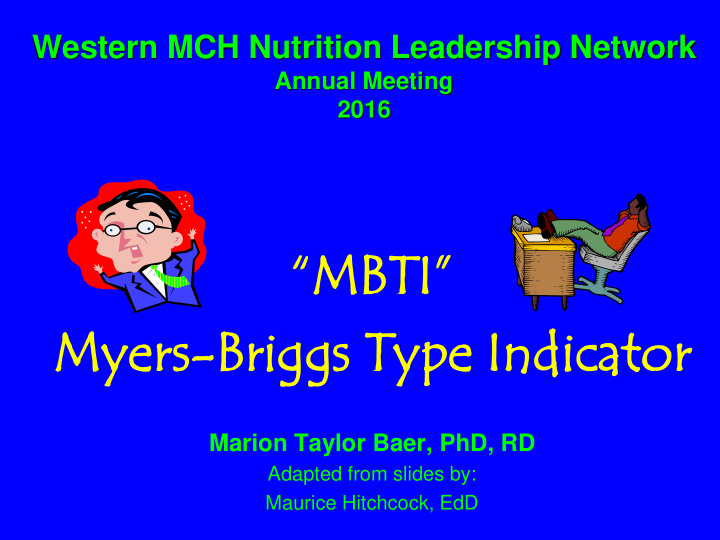



Western MCH Nutrition Leadership Network Annual Meeting 2016 “MBTI” My Myers rs-Brigg Briggs s Typ ype e In Indi dica cator tor Marion Taylor Baer, PhD, RD Adapted from slides by: Maurice Hitchcock, EdD
Origins of the MBTI • 1921: Carl Jung – people differ in fundamental ways depending on preference for how we “function” – new take on ancient idea of 4 “humours” (sanguine, choleric, phlegmatic, melancholic) – this preference is characteristic and so people can be “typed” according to their “temperament” • Normal behavior explained by answering 3 basic questions – Where do you get/expend your energy? – How do you take in information? – How do you make decisions?
Origins of the MBTI • 1930s: Behaviorists ruled – unconscious motives or past experiences define behavior • 1950s, 60s: Jung’s temperament idea revived by Isabel Myers and Katherine Briggs – developed a tool to identify 16 patterns of action – revived the ancient idea of 4 temperaments as the16 patterns fell into 4 types – added a fourth question/type to Jung’s 3: How do you want to order your world?
Jung’s Theory as interpreted by Myers/Briggs • 4 pairs of preferences: – I ntraversion vs. E xtraversion – S ensing vs. i N tuition – T hinking vs. F eeling – J udging vs. P erceiving • Preferences may change over time and functions can be developed • Inborn? Not clear. Jung believed so and types do tend to run in families, but… no solid evidence.
Four Bi-Modal Scales : • Energy Source: I or E • Where do you get your energy? • solitude vs. people • Perceiving Function: S or N • How do you take in information? • data vs. gut • Judging Function: T or F • How do you make decisions? • objective vs. subjective • Lifestyle Orientation: J or P • How do you want to order your world? • planned vs. open-ended
Energy Source E I Extroversion Introversion Gregarious Reflective External Internal Sociable Territorial People Privacy Many Few Expressive Contained Breadth Depth Speak to think Think to speak Free disclosure Cautious disclosure After thinkers Fore thinkers 70% vs. 56%=20 30% vs. 44%=15
Perceiving Function S N Sensing Intuition Details Patterns Present Future Practical Imaginative Fact Fantasy Actual Theoretical Sequential Random Perspiration Inspiration Specific General Down-to-earth Head-in clouds 70% vs. 29%=10 30% vs. 71%=25
Judging Function T F Thinking Feeling Head Heart Objective Subjective Cool Caring Impersonal Personal Critical Appreciative Analyze Empathize Precise Persuasive Principles Values Laws Circumstances Just Humane Critique Appreciate 50 % vs. 40%=14 50 % vs. 60%=11
Life-Style Orientation J P Judging Perceiving Fixed Flexible Structure Alternatives Control Adapt Decided Wait and see Scheduled Spontaneous Closure Open-minded Planned Open-ended Deadlines Targets Project Process Resolved Pending 55 % vs. 83%=29 45 % vs. 17%=6
MBTI Temperaments NT NF I NT P E NT P E NF P I NF P I NT J E NT J E NF J I NF J GUARDIAN IDEALIST SJ SP E S T J I S T J E S T P I S T P E S F J I S F J E S F P I S F P RATIONAL ARTISAN
NF 12% vs. 40%=14 MUST HAVE MEANING IN LIFE work must have significance vs. SJ ’s need for service; limiting commitments difficult future-oriented, but focused on possibilities of people vs. NT ’s principles seek interaction vs. SP ’s action prefer to work with words, communication is their strength professions: writing, poetry, teaching, journalism, psychology, psychiatry – no interest in business
12% vs. 31%=11 NT MUST BE COMPETENT, MUST KNOW live in their work; “should be able to” vs. SJ ’s “should, ought” most self-critical of all styles, perfectionist, which may delay action expects little from others except that others achieve their standards; may be emotionally insensitive, remote focus on the future; accepts change professions : science, technology, architecture, engineering
38% vs. 23%=8 SJ EXISTS PRIMARILY TO BE USEFUL, TO BE OBLIGATED, TO BELONG caregiver; parent; responsible believes in hierarchy vs. SP equality strong work ethic: “the ant” vs. the SP “grasshopper” conservator, committed to values, standards, “doing the right thing” professions: teaching, medicine, dentistry, banking, rehabilitation, ministry, librarian, civil service, middle management
38% vs. 6%=2 SP MUST BE FREE; LIVES IN THE PRESENT hungers for action, process-oriented, goals matter less impulsive, flexible, open-minded of all types, SPs work best in a crisis; bored with the status quo has endurance/survives setbacks professions : art, performing art, entertainment, adventure, athletics, racing
Source: Kiersey & Bates, Please Understand Me: Character and Temperament Types , 1984
Recommend
More recommend